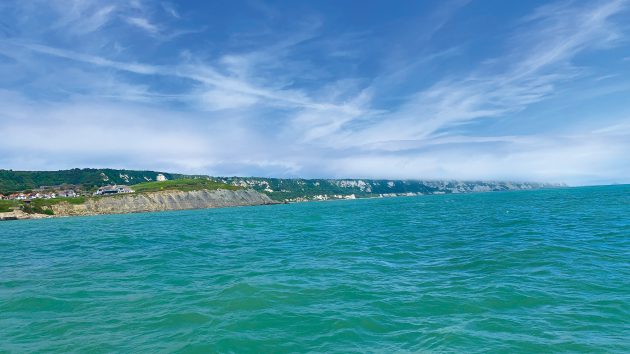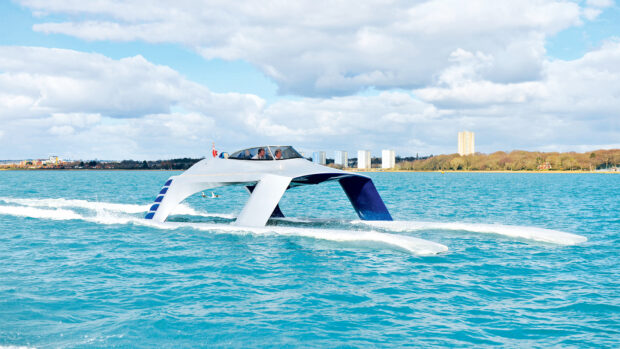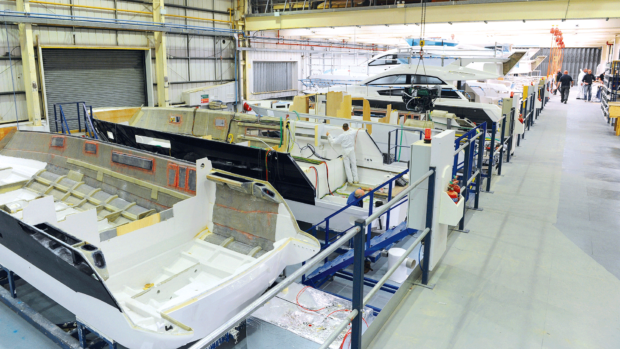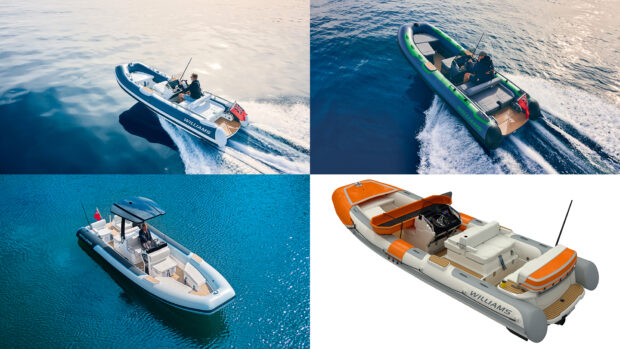Having made it from Runswick Bay, Yorkshire, to Harwich, Essex, in just one day, Ian Furby continues his attempt to circumnavigate Britain in his 18ft Nordkapp speedboat
I’ve been involved with boats for more than 30 years. In my 20s, I was an avid wreck diver and for several years I was both crew and a helm on the Runswick Bay Rescue Boat.
I have my yacht coastal skipper’s certificate and various other powerboat licences. I own a Nordkapp Enduro 550 called Summer Buoys that I bought in 2015 for £25,000. It is 18ft long and powered by a 115hp Evinrude ETEC outboard engine.
For the most boating was limited to short trips of a handful of miles, but over time I had been taking on bigger challenges and was just getting into long-distance cruising when Covid hit.
The longer we were locked up, the more I dreamed about a rather bigger adventure for me and my boat – not just a round trip to another bay but a trip round Britain.
All of it. This is a journey of 1500-2000nm, depending on how closely you hug the coastline. So if I did 200nm a day, it would take ten days to get round. Simples!
Having made it from Runswick Bay, Yorkshire, to Harwich, Essex, in just one day on the first leg of our trip round Britain it was time for the second leg of our trip.

The route ahead
Day 2: 11 June 2021 – Harwich to Folkestone: 52nm
Harty and I met as planned at 4.30am. The Pier Hotel in Harwich had kindly prepared a takeaway breakfast for us but we’d failed to anticipate the locked gate leading to the pontoon. Bugger!
Not wanting to wait hours for the office to open, I scaled the 8ft gate, jumped down and buzzed Harty through. Back aboard Summer Buoys, we stowed the covers and topped up the fuel and oil. The 115hp Evinrude E-Tec outboard on my boat is a high-tech two-stroke engine and the oil it burns is chuffin’ expensive!
Being American, it comes as an American gallon (3.75 litres) and costs around £55. In a normal year, I’ll use just over one of these for the 30 to 40 engine hours I typically do. On that basis, I calculated I would need up to 15 litres of oil for the 100 engine hours it should take me to cover the 1900nm round Britain.
To check my sums, I also contacted an Evinrude dealer, who reckoned two extra gallons on top of the 5 litres already in the tank would be fine. To be safe, I took three.

Anchored off the beach in Folkestone while the sea was too rough to continue their trip
We were both wrong. By the end of day one we’d already used a gallon of the stuff and we still had ten days to go! To be fair, in a normal season, I’m not constantly running at 4,000rpm or more and I only go out in calm conditions to avoid a mutiny from my wife and kids.
In the lumpy seas we were now tackling, the engine was having to work considerably harder. I was going to need more oil. A lot more. No worries; I’d pick some up on the way round – there’s a chandlery every five yards on the south coast!
At 5am we slipped our lines and headed out onto the Stour. The sun was just rising as we slid through the glassy water at 5 knots towards the open sea, full of excitement and anticipation.
Today’s plan was to reach Brighton, via Calais. Why? Partly because it would be fun to bag another country and partly for the bravado of crossing the Channel in an 18ft boat.
Article continues below…

Circumnavigating Great Britain in an 18ft speedboat

Boating around Britain in 26 days: How our crazy charity challenge began
Ordinarily, this wouldn’t be a problem, it’s only 22nm from Dover, but at the time we were still in the pandemic and the Frenchies had banned us from coming over. We’d make a final decision later.
In the meantime, we had a couple of options leaving Harwich: we could hug the coast via Southend-on-Sea, the Thames Estuary and the Isle of Sheppey or straight-line it to Margate. The sea was relatively flat and we were enjoying a boyish buzz about heading to France, so we plotted a course straight to Margate.
The crossing was pretty uneventful. There wasn’t much to see, other than more wind farms, sandbanks and underwater obstructions to navigate. I was amazed by how shallow the water is in this area – not that my sounder was any help, having given up the ghost within minutes of leaving Yorkshire.

Two hours and 42nm later we pulled into Ramsgate to refuel. Since the fuel berth didn’t open until 8am, we grabbed a bacon butty and a brew at the Ship Shape café before making our way to the dock, where the young lads manning the pump asked us where we were headed. “Round Britain,” we said as nonchalantly as possible. “F**k me! In that?” came the reply.
I took that a little personally, I’m very proud of my boat, although I didn’t think they meant it in an offensive way.
Rather more concerning was their reaction to our plans of going to Calais. One of the lads was crew for the Ramsgate lifeboat and warned us about the number of refugees trying to cross the Channel on small boats and the French border control ships patrolling up and down, both of which could make life very awkward for us.
Full of advice and fuel, I paid up, pleasantly surprised by the price – just 2p per litre more than road garages were charging at the time.
We pushed on towards Dover and for the next 10nm or so the going was good. But then it changed. When we left Yorkshire on Wednesday, the forecast had been flat, flat, flat for the next five days. It was now Friday morning, and it wasn’t flat – not even close.

Harty taking a break
The Magic Seaweed surfing app I use for predicted wave heights (now called Surfline) was saying 0.5–1ft. The six-footers I was looking at said differently.
As we rounded Dover and lost the lee of the land, we felt the full force of a 20-knot southwesterly on our nose. When combined with the strong tidal flow trying to squeeze through the narrow Dover straits, it meant the sea was lifting – a lot!
The boat was coping well enough but it was hard work and the engine was using more oil. Arghhh!
Folkestone to Rye :27nm
We abandoned the idea of going to Calais, setting our sights on Brighton instead. I’d never been there and was looking forward to seeing the town but with the sea still lifting, we decided to pull into Folkestone and sit it out for a bit.
With more than an hour before high tide and no pontoons in the harbour, we nosed up to the beach, took the anchor ashore and ran a stern line to the harbour wall to keep us afloat.
That gave us two hours to explore the city. We went for a wander down the cobbled streets, passed some welcoming-looking pubs that could have been dangerous if we’d ventured into them, and stopped at a seafood stall to sample their wares while looking at the forecast and revising our plan. We hoped to continue once the tide had turned and taken the edge off the sea state.

Hanging out sodden clothes to dry
Two hours later, we topped up the tank from the jerry cans and left the harbour. The skies had cleared and the sun was poking its nose out. For a while we made steady headway in the lee of the land but as soon as we rounded Dungeness Point, things went to shit. The southwesterly was now blowing uninterrupted from the Atlantic right onto our nose.
Brighton was still 40nm away, our speed was down to 10 knots and helming was becoming a fight. Not fancying another four hours of this, we decided to head for the closest ‘bail-out’ port I’d marked on my chart, in this case, Rye, 5nm away.
Standing at the helm so we could read the sea and bend our knees to absorb the hits, we gritted our teeth and battled on.
The waves were crashing over us and we were getting very, very wet. We weren’t too worried, though, as we were both used to it from our rescue boat training in Yorkshire. In between spitting out seawater, I remember thinking, “By ’eck, that sea’s blue. It ain’t like that at home.”
At 2.30pm, we finally entered the long man-made channel leading to Rye. The sun was beaming down and we were both grinning like idiots. I hailed the harbourmaster on Channel 14 but got no answer.
We carried on upstream until we found some old boys tinkering with a boat. We asked if there were any visitor berths in Rye? They said there were but they dried out at low tide. Not wanting to be a hostage to the tide, we headed back downstream, looking for somewhere else to moor. We found a pontoon on the west bank of the river, tied up and hung our kit out to dry in the afternoon sun.

Keeping the spirits up with a sundowner
Harty logged on to booking.com to find a bed for the night while I topped up the tanks. The news was bad on both counts; the big seas had taken their toll on the fuel and oil, and there wasn’t a bed to be found anywhere – nada, not one. Furthermore, both our phones had water in the charging port and wouldn’t charge.
With the boat made safe, we headed through the sand dunes in the direction of town, only to discover we were in a locked gravel compound surrounded by a spiked 10ft steel fence. My athletics in Harwich weren’t going to work here. While we were considering our options, a dog started barking, and it wasn’t a happy bark.
A lady appeared at the gate, opened it and released the angry pooch, which promptly galloped towards us.
Fortunately Harty and I are ex-farmers and have worked with dogs most of our lives. We could see Fido was a labrador, and both labradors, and the people who own them, tend to be decent sorts.
I crouched down, looked the dog in the eye and held out my fist so he could have a sniff. Thirty seconds later, I had a new mate. His owner, however, was not looking happy, and to be fair to the lady, we were in the wrong.
I explained our plight and showed her that I had tried to phone the harbour master. Our plan was to go into town, grab some grub and try to find some digs; if we failed, we would head back and kip on the boat. Penny, as we discovered she was called, listened to our tale, gave me her number and asked us to keep her informed. If we failed to find a hotel, she would text me the code for the gate. That done, she let us out. We thanked her profusely and marched a good mile into town.

Sunset in Rye
It was absolutely cracking flags as we stumbled into the Rye Lodge Hotel. There were no rooms available but that didn’t stop us getting stuck into a couple of Peronis followed by some excellent homemade pizzas.
We settled up and headed back to the boat, picking up a couple of bottles of Sauvignon to aid sleep. Even though Summer Buoys is an open boat with no sleeping accommodation, we had kitted her out for camping aboard just in case. I dropped Penny a text and she pinged me the gate code. Penny, if you’re reading this, thanks again – you were an angel.
When we got back to the boat, it was sitting in mud. The old boys we’d met, said it would stay afloat here, so I’d not lifted the engine and the prop was now submerged in mud. Rather than make matters worse, we enjoyed the wine on the pontoon and waited for the tide to return.
That just left the issue of our soggy, waterlogged phones. If we’d been at home, we would have stuck them in a bowl of rice in the airing cupboard but, surprisingly, I had no rice nor airing cupboard to hand. I did have some instant porridge, though, so I propped the phones upside down in a dry bag surrounded with the porridge and left the oats to work their magic.
Now that the tide had returned, it was time to set up camp. Summer Buoys has a convertible sunbed in the bow and a long rear bench in the stern. Harty bedded down here using a sleeping bag and the cockpit cover to keep the dew off.
Up for’ard in first class, I had a slim micro-airbed with an integral pillow, sleeping bag and a tarp pulled over me.
We got our heads down and quickly nodded off. As I’m old and had a few drinks inside me, I was up at 1am to empty the tank. The tide was already going out. Hmm. I went back to bed.

Stuck in the mud on the channel up to Rye
Day 3: 12 June – Rye to Cowes: 79nm
I awoke at 4am feeling surprisingly fresh. We made ready, dug out our phones from their porridge bath and tried charging them. Fail. We now had two issues to resolve: phones and two-stroke oil.
We slipped our lines and headed downriver. As we neared the harbour entrance, I noticed another problem. In front of us was breaking water, which very shortly would be dry land.
In all the excitement, I had forgotten that access to Rye is only possible plus or minus two hours from high water. Our only hope was that Summer Buoy’s draft of just 0.5m would give us a bit more leeway.

Passing the iconic Seven Sisters coastline off East Sussex
Harty stripped down to his shorts and took the helm. I put on my waders and sat on the bow. If we did ground, we’d both jump out and push. After five minutes of tension, we were through but I was cross with myself for making another schoolboy error.
That aside, our spirits were high. The sea was flat and we were en route to Brighton. Now all we had to do was keep the coast on our right for 40nm and stop when we saw a big pier.
By 7.30am we were in Brighton marina and taking a spanking at the fuel berth – £1.77p per litre. Half an hour later, we were back underway. After a few miles, we saw an island in the distance with sun bouncing off its towering white cliffs. So that’s why it’s called the Isle of Wight.
We both stood and stared. The clouds had disappeared, the sea had turned to glass and all was well.

A brief refuelling stop in Brighton topped up the tanks but emptied their wallets
Dodging the frenzy of ships, yachts and motorboats, we threaded our way towards Cowes in the hope of finding a phone shop. We tied up at the West Cowes Terminal and 30 seconds later were in town.
We soon discovered the nearest phone shop was in Newport, 20 minutes away by bus. When we got there, the lad behind the counter didn’t have a quick fix for the sodden charging points but did come up with a pearler. “You do know these phones have contactless charging?”
Doh! With so much else going on, we hadn’t thought of that. We bought a couple of contactless chargers and legged it back to Cowes wondering whether we’d find our boat boxed in by other boats. Remarkably, there was a RIB behind us with eight RIBs rafting off it and another in front of us with six RIBs rafting off it, but on us there was nothing. I wasn’t sure whether to take offence or thank our lucky stars.
Pausing only to top with fuel at a wallet-withering 187p litre, we taped our phones to the contactless chargers and set off again.

Tied up in Cowes while they frantically hunted for a phone shop to fix their waterlogged mobiles
Cowes to Weymouth via Hamble: 67nm
Harty’s brother, Tommy, lives in Hamble, just across the Solent from where we were in Cowes so it seemed daft not to pop over and see him briefly. The weather was still fabulous and the sea would have been flat were it not for the thousands of boats criss-crossing the Solent. We dashed across, found Tommy out on the water with his daughters, grabbed a quick cuppa with his wife Rachel and got on our way again.
My original goal for tonight was Plymouth, but having been blown out in Rye and diverting to Cowes we were well behind schedule. Pushing on westwards, we kept the mainland close to starboard as we punched through the messy overfalls between Hurst Point and the Needles against a ripping tide.

A quick visit to The Hamble
After Christchurch, the sea began to flatten out and before long we were cruising past Old Harry Rocks towards Portland. Now we had to decide whether to hug the shore then loop round the Isle of Portland or straight-line it to Portland Bill and save 6nm but risk being exposed to bigger seas.
We chose the latter. It wasn’t flat but it was manageable.
Mid crossing, we went across the Adamant Shoal. In the distance, looming out of the haze, were several huge unidentifiable shapes. As we approached, they became taller, higher and longer until finally it dawned on us. They were cruise liners, casualties of the pandemic, lying dormant and waiting for the world to restart. It was like a scene out of a disaster movie and a sight that neither of us will ever forget.

Dorset’s Old Harry Rocks provided another notable landmark on their journey West
Weymouth to Brixham: 49nm
By the time we passed the ghost-ship graveyard it was gone 6pm. Tucked in under the shadow of Portland Bill lighthouse, we paused, refuelled from the jerry cans and topped up the oil. We now had just one gallon left.
Plymouth was still 100nm and five hours away. We weren’t going to make it. My back-up plan was Torquay, 60nm and three hours away if we stuck close to shore but only 40nm if we straight-lined it across Lyme Bay.

Watching the sun set over Brixham marina after covering almost 200nm in one day
We decided to go for it. At the mid-way point, we were 15nm offshore and for the first time we were completely out of sight of land. It was an exhilarating feeling.
Steaming into Torbay, I looked for the cluster of yacht masts that indicated Torquay marina and steered towards it. We didn’t realise at the time but it wasn’t Torquay we were heading for, but Brixham!
I was a little disappointed when the penny dropped. As a working-class lad, dragged up in the 1970s, we couldn’t afford to go on holiday but I did have friends who holidayed in this mythical place called Torquay, so the chance to visit it in my fifty-fourth year felt like an opportunity missed.
On the plus side we had completed just shy of 200nm in a single day. It seemed a lifetime since we’d left Rye that morning.
Elated but exhausted we went for a couple of pints at the Prince William bar. Harty was leaving in the morning and neither of us wanted it to end. We’d enjoyed a magical few days together and some of the prettiest coastline lay ahead but Harty had a business to run.

Packing away the tarpaulin and covers used as makeshift tents to sleep on board the open Nordkapp 550
We were too late to find a restaurants that was open, but I’m not sure they’d have welcomed us anyway. We’d been wearing the same clothes for almost three days. We were sun-kissed, covered in salt crystals and we stank. Boy, did we stink.
So, Harty set off to get a Chinese takeaway while I went to the local Co-op to grab a couple of bottles of Sauvignon. Meeting back at the boat, we tucked into our banquet before collapsing into our makeshift beds, listening to the gentle tapping of halyards against masts.
Next month
Ian goes it alone, stopping off at the Scilly Isles before dashing back to Padstow and crossing the Bristol channel to Milford Haven










